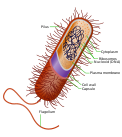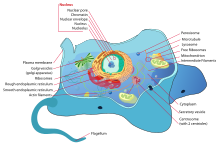Cell physiology
This article may be too technical for most readers to understand. (December 2019) |
Cell physiology is the biological study of the activities that take place in a
General characteristics
There are two types of cells: prokaryotes and eukaryotes.
Prokaryotes were the first of the two to develop and do not have a self-contained
Prokaryotes

Prokaryotes have DNA located in an area called the nucleoid, which is not separated from other parts of the cell by a
Eukaryotes

Eukaryotes have a nucleus where DNA is contained. They are usually larger than prokaryotes and contain many more organelles. The nucleus, the feature of a eukaryote that distinguishes it from a prokaryote, contains a
Physiological processes
There are different ways through which cells can transport substances across the cell membrane. The two main pathways are passive transport and active transport. Passive transport is more direct and does not require the use of the cell's energy. It relies on an area that maintains a high-to-low concentration gradient. Active transport uses adenosine triphosphate (ATP) to transport a substance that moves against its concentration gradient.[4][page needed]
Movement of proteins
The pathway for proteins to move in cells starts at the ER.
Transport of ions

Ions travel across cell membranes through channels, pumps or transporters. In channels, they move down an electrochemical gradient to produce electrical signals. Pumps maintain electrochemical gradients. The main type of pump is the Na/K pump. It moves 3 sodium ions out of a cell and 2 potassium ions into a cell. The process converts one ATP molecule to adenosine diphosphate (ADP) and Phosphate.[clarification needed] In a transporter, ions use more than one gradient to produce electrical signals.[3]

Endocytosis in animal cells
Endocytosis is a form of active transport where a cell takes in molecules, using the plasma membrane, and packages them into vesicles.[2]: 139–140
Phagocytosis
In phagocytosis, a cell surrounds particles including food particles through an extension of the
Pinocytosis
In pinocytosis, a cell takes in ("gulps") extracellular fluid into vesicles, which are formed when plasma membrane surrounds the fluid. The cell can take in any molecule or solute through this process.[2]: 139–140
Receptor-mediated endocytosis
Receptor-mediated endocytosis is a form of pinocytosis where a cell takes in specific molecules or solutes. Proteins with receptor sites are located on the plasma membrane, binding to specific solutes. The receptor proteins that are attached to the specific solutes go inside coated pits, forming a vesicle. The vesicles then surround the receptors that are attached to the specific solutes, releasing their molecules. Receptor proteins are recycled back to the plasma membrane by the same vesicle.[2]: 139–140
References
- ISBN 978-1-938168-13-0. Archived from the originalon November 1, 2020. Retrieved October 23, 2019.
- ^ OCLC 956379308.
- ^ OCLC 70047489.
- ISBN 978-1-947172-51-7.
External links
- Overview at Medical College of Georgia (archived)
- Cell Physiological Phenomena at the U.S. National Library of Medicine Medical Subject Headings (MeSH)
- Electrophysiology at the U.S. National Library of Medicine Medical Subject Headings (MeSH)

